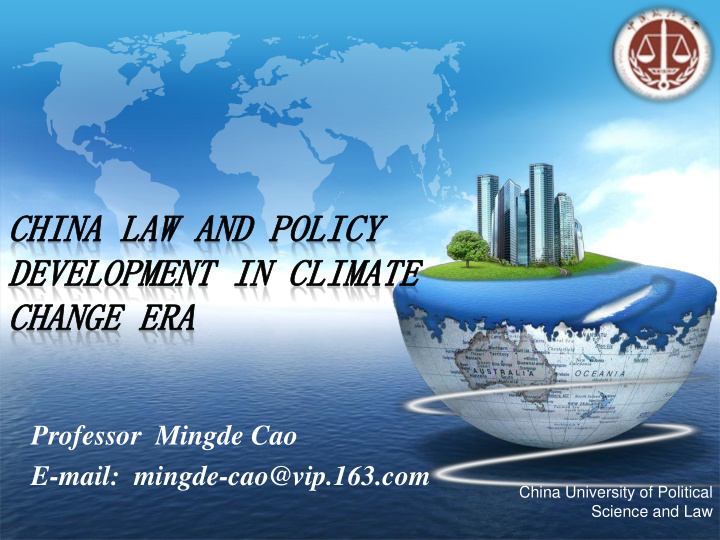



LOGO Professor Mingde Cao E-mail: mingde-cao@vip.163.com China University of Political Science and Law
Content I. China’s Law and Policy Responding to Climate Change II. China’s Current Measures to Deal with Climate Change III. China’s Possible Options to Climate Change
I. China’s Laws and Policies Responding to Climate Change A. The social economic background of China’s climate law and policy By the end of 2008, the total population in the mainland was 1.328 billion. In 2008, with a per capita GDP of US$ 3,268, China still ranked among low to mid-income countries. China also has 40.07 million rural residents under the poverty line by the end of 2008.
I. China’s Laws and Policies Responding to Climate Change B. National laws have been enacted: Renewable Energy Law Energy Conservation Law Cleaner Production Promotion Law Circular Economy Promotion Law Forest Law and Grassland Law Air Pollution Prevention Law
National Laws China is going to make Energy Law , and revise Coal Law, Power Law, Climate Change Act (draft before 2015, NDRC), etc. Provincial Regulations Two provincial level regulations on dealing with climate change, Qinghai province, Shanxi province. Guangdong has already made draft. Jiangsu province is considering to make a draft, I am chairing the project which is sponsored by Energy Foundation.
Policies to Deal With Climate Change China’s National Climate Change Program White Paper: China’s Policies and Actions on Climate Change 2008 Resolution on Climate Change by the Standing Committee of NPC
Policies to Deal With Climate Change 12 th FYP set three environmental targets : --16% energy intensity reduction target, --17% carbon intensity reduction target, --a target to increase non-fossil energy sources to 11.4 % of primary energy consumption from the current 8.3 %.
II. The Current Policies and Measures 1. the policy to optimize the industrial structure Central government now focused on controlling energy-intensive, outdated and highly polluting industries. Now promoting energy-saving and environment protection industry, new generation information technology, biotechnology and precise equipment manufacturing, new energy, new material and new- energy automobiles
2. Promoting low-carbon energy China has formulated a series of policies to promote low-carbon energy, such as hydropower, wind, solar, biomass.
3. Advocating the low carbon economy Laws and regulations have been formulated: Circular Economy Promotion Law Energy Conservation Law Renewable Energy Promotion Law Regulations on energy conservation of public institutions
4. Encouraging the less carbon consumption China has successively made a series of policies that aim to encourage the low carbon consumption, such as rules promoting the efficient and energy-saving domestic air conditioning units
5. Increasing carbon sequestration China has promulgated some policies, including the Notice of Suggestion on Strengthening the Management of the Carbon Sink Forestation.
6 . Hierarchy of responsibilities for Energy-saving During the Eleventh Five-Year Plan, to reduce the energy consumption per unit GDP by 20%, China progressively assigned the target of energy-saving to local government, and requested the local officials responsible for failing to achieve the goals.
7. Standards Pollution discharge standards — Provisional Standards of Coal Gas Emission, the Solid Wasted Landfill Pollution Control Standard and the Pollutant Emission Limits, Performance standards — Methods of Measurement of heavy vehicles with gasoline engines and automobile exhaust (stage Ⅲ and stage IV in China).
8. Energy Labels and Quotas China has implemented a series of energy efficiency limits for domestic, commercial or industrial energy- intensive products including: Energy Efficiency Quotas and Ratings for Microcomputer & Flat-panel TVs
9. Taxes The differential rate of excise tax can help reduce GHG emissions. For example: Cylinder capacity is less than or equal to 250ml, the motorcycle excise tax rate is 3%. Cylinder capacity is more than 250ml, motorcycle excise tax rate is 10%.
III. China’s Possible Options to Address Climate Change Direct regulatory measures combine with market instruments 1. Carbon Cap and Trade The traditional command and control measures should be combined with voluntary measures and economic incentives, such as carbon emission trading mechanism and taxation.
2. Carbon taxation and Emission Trading Carbon taxation and emission trading are crucial market tools to internalize the social costs of GHGs. Carbon emission trading can ensure environmental benefits, but the amount of GHG emission reductions are uncertain. Carbon taxation puts costs on emission reductions, but its environmental benefits are uncertain. The General Director of the Department of Climate Change of NDRC has shown more interest in carbon emission trading than carbon taxation.
3. Climate impact assessment on construction projects, plans, policies and strategies The construction projects, plans, policies and strategies have locking effect on GHGs emission reduction. Decisions to architecture, cities and infrastructure design will influence climate and energy for decades in future. Plan and infrastructure design will have long-range impact on GHGs emission and climate change.
4. Monitoring reporting and verification of GHGs emission China’s central government should set up certain institutions to monitor report and verify the emission reduction of facilities regularly, compile the GHGs emission inventory and disclose it to the public. China needs to set up athird-party independent entity is in charge of the verification of the emission report of the enterprises. The false deceive report or failing to report should be liable.
5. Promotion for low carbon consumption The existing tiered price of resource and water, automobile excise tax system are relatively successful. In the future legislation, China should expand the tiered price system to the real estate consumer, high carbon emission luxury consumption and other service and product by adjusting the tariff to promote low consumption.
6. Forests as carbon sinks: carbon trade and compensation Developing forestry, to the benefit of ecosystems and GHG emission reduction, is a useful measure without any negative aspects. In 2009, State Forestry Administration published Action Plan For Forestry to Address Climate Change, determining the goal of 3 stages and 22 main actions of forestry development.
LOGO
Recommend
More recommend